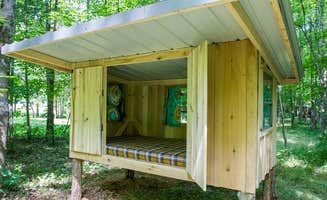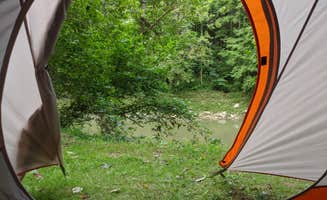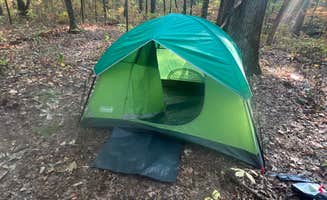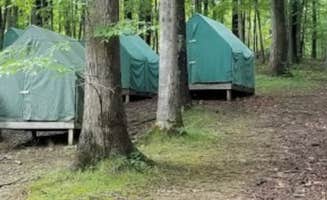Tent camping near Celestine, Indiana offers opportunities for primitive camping in the Hoosier National Forest. The area sits at approximately 600-700 feet above sea level, with rolling hills, limestone outcroppings, and multiple creek watersheds. Seasonal changes affect site conditions significantly, with spring bringing muddy access roads and fall offering prime wildlife viewing when deciduous trees shed their leaves.
What to do
Explore creek watersheds: Mitchell Creek Road area features several small creeks where campers can hike and search for geodes. "I walked the creek for hours just looking at all the rocks on the sandbars. I have never encountered so many geodes in my life. Truly magnificent to encounter," noted one visitor to Charles C. Deam Wilderness.
Rock formation hiking: Explore unique limestone formations within short driving distance of primitive sites. "The area is maintained by seasonal residents and is in amazing shape. Bathrooms and showers are both incredibly clean," reports a camper about the nearby Pine Loop area, which provides access to similar terrain.
Kayaking access points: Blue River offers popular paddling routes with tent sites available near takeout points. "The end of a kayaking trip is there so the buses to pick up kayakers are in and out and gets pretty busy at the end of the day," reports a camper at Old Mill Tent And Hammock Camping.
What campers like
Isolation from technology: Limited or no cell service creates a truly disconnected experience in most forest camping areas. "Spot has a creek and is flat enough for a tent mostly just a single person spot no toilets," notes one reviewer of Mitchell Creek Road who appreciates the simplicity.
Wildlife encounters: Dawn and dusk bring increased wildlife activity near secluded campsites. "At night, we heard some loud mysterious crashing in some nearby trees, and what was possibly a large band of coyotes in the distance," reported a camper describing their experience at primitive sites.
Hammock-friendly forests: Dense tree coverage throughout the region creates ideal hammock camping setups. "The forest is beautiful and we had no problems with ticks or mosquitoes while sleeping in our hammocks," according to a visitor at Happy Hollow Homestead, noting the comfortable sleeping arrangements.
What you should know
Road access challenges: Some tent sites require careful navigation on unpaved roads that deteriorate after rainfall. "After 5 min of driving on the very skinny gravel road y saw what it look like spots but Iam not sure really. 10 min later I got to the coordinates and there was nothing," describes one solo traveler attempting to find Mitchell Creek Road sites.
Site identification: Most primitive sites lack clear markings or defined boundaries. "There are just a couple of sites along the road. One is at the trail crossing for horses, hikers, and bikers. Its basically a make your own campsite," explains a camper about the dispersed options.
Seasonal variations: Spring brings significantly wetter conditions to the best tent camping near Celestine, while summer increases visitor traffic. "The weekend we were there was during the Summer Soulstice music festival. The campground was very lively and everyone was having fun," notes one Happy Hollow Homestead visitor, highlighting how events can change the camping experience.
Tips for camping with families
Bathroom planning: Most primitive sites have no facilities, requiring families to plan accordingly. "This is a bare bones location. There was evidence of a homemade fire pit and a small cleared area," notes a Mitchell Creek Road camper, emphasizing the lack of amenities.
Safer alternatives: Families seeking more structure should consider established campgrounds within 30-45 minutes of Celestine. "Lots of fun activities to do, and great hiking trails. Their mess hall is top notch. We have camped here in a cabin, and also tent camped," reports a visitor to Ransburg Scout Reservation.
Water sources: Pack adequate water or water filtration systems as natural sources may be unreliable. "Heads up! Refill your water when you come across it; the lake is harder to get to than you think. I would also bring bug spray and check for ticks!" advises a Charles C. Deam Wilderness camper.
Tips from RVers
Size limitations: Only small campervans and truck campers can access most remote sites near Celestine. "I did not see any pull offs that would accommodate an RV of any size, and nothing large enough to turn a trailer around. One pull off was nearly too small to turn around my small pick up truck," cautions a Mitchell Creek Road visitor regarding vehicle access.
Cell signal boosting: Signal boosters help maintain communication in remote areas. "No cell service at the site but there was a bar or two on the road just a few feet away. With a weboost there was att and tmobile service," notes a camper who successfully maintained limited connectivity.
Alternative parking options: Some areas offer more space for larger vehicles at main access points. "A big white building that was all locked up surrounded by open meadow that a larger vehicle might be able to park behind. A circular drive was mown around the building," describes one camper who found alternative parking near Mitchell Creek Road.





